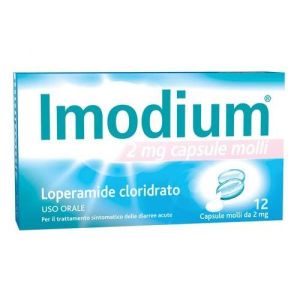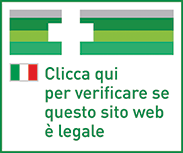Ship in Europe, Find out rates!
Imodium 2mg Loperamide Hydrochloride product 12 Soft Capsules

- box Delivery in Italy in 24/48 and free returns
- star3.000+ positive reviews
- dropboxOver 60,000 products in the catalog
Imodium 2mg 12 soft capsules is used in the symptomatic treatment of acute diarrhea.
PHARMACOTHERAPEUTIC CATEGORY:
Anti-propulsants.
ACTIVE PRINCIPLES:
Loperamide hydrochloride.
EXCIPIENTS:
2 mg hard capsules: lactose, corn starch, talc, magnesium stearate.
A gray-green hard capsule consists of: erythrosine (E 127); indigo carmine (E 132); yellow iron oxide (E 172); black iron oxide (E 172); titanium dioxide and gelatin to taste
to one capsule.
2 mg effervescent tablets: anhydrous citric acid, sodium bicarbonate, sodium chloride, potassium chloride, anhydrous glucose, sorbitol, macrogol 6000, sodium saccharin, lemon flavor powder.
2 mg buccal tablets: gelatin, mannitol, aspartame, mint flavor, sodium bicarbonate.
>> Soft capsules 2 mg.
Capsule contents: propylene glycol monocaprilat, propylene glycol, distilled water.
Capsule shell: gelatin, glycerol 99%, propylene glycol, FD & C blue No.
1.
INDICATIONS:
Symptomatic treatment of acute diarrhea.
CONTRAINDICATIONS / SECONDAR EFFECT:
Not to be used in children under 6 years of age; pregnancy and breastfeeding.
Loperamide HCl should not be used as attack therapy in acute dysentery characterized by blood in the stool and high fever.
It should also not be given to patients with acute ulcerative colitis or pseudomembranous colitis due to the use of broad spectrum antibiotics nor should it be given to patients with bacterial enterocolitis caused by invasive organisms including S almonella, Shigella and Campilobacter.
In general, the use of Loperami de HCl is contraindicated in all cases in which an inhibition of peristalsis must be initiated due to the possible risk of significant consequences such as ileus, megacolon and toxic megacolon.
If constipation, abdominal distension or sub-ileus occurs, stop the treatment immediately.
DOSAGE:
>> Adults and children aged between 6 and 17 years.
Hard and 2 mg capsules: the starting dose is 2 capsules (4 mg) for adults and 1 capsule (2 mg) for children to be taken by mouth to be taken with a little liquid.
2 mg effervescent tablets: the initial dose is 2 effervescent tablets (4 mg) for adults and 1 effervescent tablet (2 mg) for children to be taken dissolved in a glass of water.
2 mg buccal tablets: the initial dose is 2 buccal tablets (4 mg) for adults and 1 buccal tablet (2 mg) for children to be left to dissolve for a few seconds on the tongue.
Soft capsules 2 mg: the starting dose is 2 soft capsules (4 mg) for adults and 1 soft capsule (2 mg) for children to be taken by mouth to be taken with a little liquid.
Thereafter 1 capsule or 1 effervescent tablet or 1 buccal tablet (2 mg) or a soft capsule (2 mg) after each subsequent evacuation of unformed (soft) stool.
For adults the maximum daily dose is 8 capsules or tablets per day (16 mg).
For children, the dose must be related to body weight (3 capsules or tablets / 20 kg) but must not exceed a maximum of 8 tablets per day.
Do not use for more than 2 days.
In fact, in episodes of acute diarrhea, loperamide HCl is generally able to stop the symptoms within 48 hours.
After this period without appreciable results, stop the treatment and consult your doctor.
The treatment, in any case, must be interrupted when the stool is normalized, or if there have been no more bowel movements for 12 hours, or if constipation appears.
Elderly: No dose adjustment is necessary.
Renal dysfunction: no dose adjustment is necessary.
Hepatic dysfunction: Although data are not available in patients with hepatic dysfunction, loperamide HCl should and be used with caution in these patients due to reduced first pass metabolism.
STORAGE:
Store in the original package to protect the medicine from humidity.
Soft Capsules: Do not store above 25 degrees C.
Keep the blister in the original package to protect the medicine from light.
WARNINGS:
Treatment of diarrhea with Loperamide HCl is symptomatic only.
Therefore, where possible, it is also advisable to intervene on the causes of the disorder.
In patients with diarrhea, especially in children, fluid and electrolyte depletion may occur.
In such cases it can be very important to properly replenish the liquids and electrolytes themselves.
For this reason, the effervescent tablets contain the elements to replenish these losses.
Each effervescent tablet provides 500 mg of glucose and the following intake of electrolytes: sodium 260 mg (11.3 meq); potassium 80 mg (2.0 meq); chloride 234 mg (6.6 meq).
Each effervescent tablet contains 0.5 g of glucose: this should be taken into account for people with diabetes.
It is advisable to discontinue treatment with Loperamide HCl if there is no improvement in clinical symptoms within 48 hours and following the start of therapy.
Loperamide is subject to an intense first pass metabolism.
The drug should be used with caution in patients with hepatic insufficiency as it can lead to a relative overdose with CNS toxicity.
Patients with AIDS treated with Loperamide HCl for diarrhea must stop therapy at the first signs of abdominal distension.
In these patients with infectious colitis of bacterial or viral origin, treated with loperamide hydrochloride, there have been isolated cases of constipation with an increased risk of toxic megacolon.
The hard capsules contain lactose.
The effervescent tablets contain sorbitol and glucose.
In children between 6 and 12 years of age, the medicine should only be used under medical supervision.
Rigid capsules: 8 capsules - swallow the capsules with a little water.
Effervescent tablets: 10 tablets - dissolve the effervescent tablet in a glass of water.
Buccal tablets: 12 tablets - place the tablet on the tongue.
The tablet will dissolve rapidly from the s aliva.
The buccal tablets do not require the use of water.
Soft capsules: 12 soft capsules - swallow the capsules with a little water.
INTERACTIONS:
Non-clinical data have shown that loperamide is a substrate of P-glycoprotein.
Concomitant administration of l operamide (single 16 mg dose) with quinidine and ritonavir (both P-glycoprotein inhibitors) resulted in 2 to 3-fold increases in plasma loperamide levels.
The clinical relevance of this pharmacokinetic interaction with P-glycoprotein inhibitors when loperamide is administered at recommended doses (2 to a maximum of 16 mg per day) is unknown.
Concomitant administration of loperamide (as a single 4 mg dose) and itraconazol o, an inhibitor of CYP3A4, and of P-glycoprotein, resulted in a 3-4-fold increase in plasma levels of loperamide.
In the same study, gemfibrozil, an inhibitor of CYP2C8 showed a 2-fold increase in plasma levels of loperamide.
The combination of itraconazole and gemfibrozil showed a 4-fold increase in the loperamide peak plasma level and a 13-fold increase in total plasma exposure.
These increases were not associated with central nervous system (CNS) effects as detected by psychomotor tests (e.g. subjective dizziness and the Digit Symbol Su bstitution Test).
Concomitant administration of loperamide (single dose of 16 mg) and ketoconazole, a CYP3A4 inhibitor, and P-glycoprotein, resulted in a 5-fold increase in plasma levels of loperamide.
This increase was not associated with an increase in pharmacodynamic effects as detected by pupillometry.
Concomitant treatment with oral desmopressin resulted in a 3-fold increase in plasma desmopressin concentrations, presumably due to slowed gastrointestinal motility.
Concomitant use of CYP 450 inhibitors is not recommended.
Concomitant treatment with substances with similar pharmacological properties can enhance the effect of loperamide and substances that accelerate gastrointestinal transit can decrease its effect.
Interactions are possible with drugs having pharmacological properties similar to those of loperamide or drugs that can slow intestinal peristalsis (eg.
anticholinergics), as the effects of the drug could be enhanced.
SIDE EFFECTS:
Adults and children aged> = 12 years: acute diarrhea and chronic diarrhea.
The most commonly reported adverse drug reactions (ADRs) (i.e. with an incidence> = 1%) in clinical trials with Loperamide HCl for the treatment of acute diarrhea were the following: constipation, flatulence, headache and nausea.
In clinical trials for the treatment of chronic diarrhea, the most commonly reported ADRs (ie> = 1% incidence) were the following: flatulence, constipation, nausea and dizziness.
The following shows the ADRs that have been reported with the use of Loperamide HCl both in clinical trials (in case of acute or chronic diarrhea, or both), and in post-marketing experience.
By convention, based on their frequency, undesirable effects have been divided into the following categories: very common (> = 1/10); common (> = 1/100 to <1/10); uncommon (> = 1 / 1,000 to <1/100); rare (> = 1 / 10,000 to <1 / 1,000); and very rare (<1 / 10.0 00).
>> Acute diarrhea.
Nervous system disorders.
Common: headache; uncommon: dizziness.
Gastrointestinal disorders.
common: constipation, nausea, flatulence; uncommon: abdominal pain, abdominal discomfort, dry mouth, pain in the upper abdomen, vomiting; ra ro: abdominal distension.
Pathology of the skin and subcutaneous tissue.
Uncommon: rash.
>> Chronic diarrhea.
Pathologies of the nervous system.
Uncommon: headache; common: dizziness.
Gastrointestinal disorders i.
Common: constipation, nausea, flatulence; uncommon: abdominal pain, abdominal discomfort, dry mouth, dyspepsia.
>> Acute + chronic diarrhea and post-marketing experience.
Disorders of the immune system.
Rare: hypersensitivity reaction, anaphylactic reaction (including anaphylactic shock), anaphylactoid reaction.
Pathologies of the nervous system.
Common: headache, dizziness; uncommon: somnolence; rare: loss of consciousness, stupor, decreased level of consciousness, hypertonia, coordination disturbances.
Eye disorders.
Rare: miosis.
Gastrointestinal diseases.
Common: constipation, nausea, flatulence; uncommon: abdominal pain, abdominal discomfort, dry mouth, pain in the upper abdomen, vomiting, dyspepsia; rare: ileus (including paralytic ileus), megacolon (including toxic megacolon), glossodynia, abdominal distension.
Pathology of the skin and subcutaneous tissue.
Uncommon: rash; rare: bullous rash (including Stevens-Johnson syndrome, toxic epidermal necrolysis and erythema multiforme), angioedema, urticaria, pruritus.
Renal and urinary disorders.
Rare: urinary retention.
General disorders and administration site conditions.
Rare: fatigue.
For ADRs reported in clinical trials for which frequency is not presented, the term has not been observed, nor is it considered an ADR for this indication.
Children: The safety of Loperamide HCl was evaluated in 607 patients aged 10 days to 13 years, who participated in 13 controlled and uncontrolled clinical trials with Loper amide HCl used for the treatment of acute diarrhea.
In general, the profile of ADRs in this patient population was similar to that observed in clinical trials with Loperamide HCl used in adults and children aged 12 years and over.
The reporting of suspected adverse reactions that occur after the authorization of the drug is important, as it allows continuous monitoring of the benefit / risk ratio of the drug.
PREGNANCY AND BREASTFEEDING:
The administration of the product during pregnancy is not recommended.
Pregnant or lactating women should therefore consult their doctor for appropriate treatment.
| Destination | Cost | Detail |
|---|---|---|
| Italy | €5,90* | 24/72H |
| Austria, France, Germany, Slovenia | € 13* | 3 days |
| Belgium, Luxembourg, Portugal, Netherlands, Spain | € 14* | 4 days |
| Bulgary, Cechia, Hungary, Poland, Romania, Slovakia | € 19* | 5 days |
| Denmark, Estonia, Finland, Ireland, Lithuania, Latvia ,Sweden | € 22* | 5 days |
| United Kingdom, Switzerland, Greece, Malta/td> | € 30* | 7 days |
| Canada | € 40 | 7 Days |
European shipments with express courier: FedEx, MBE, DHL
*For the shipment outside band B ther's an extra cost of 22€ *For the shipment outside band C ther's an extra cost of 30€ Delivery Times exclude Saturday and Holidays
For Islands and Areas of difficult Accessibility the shipments are made in 72 hours and the cost will be increased by 15€


